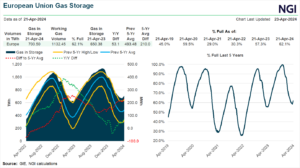Markets | Earnings | NGI All News Access | NGI Data
August Natural Gas Futures Bounce Back Despite Mixed Views on Weather, Export Demand
August natural gas futures rebounded Tuesday amid news of continued robust exports to Mexico and a varied weather outlook that anticipates cooler near-term conditions but potential for heat to intensify in coming weeks.

Analysts cautioned trading would be choppy ahead of the September contract becoming the front month on Thursday. The August Nymex contract rose 6.6 cents day/day and settled at $1.800/MMBtu on Tuesday. The prompt month dropped 7.4 cents the prior day. September climbed 7.8 cents to $1.864 on Tuesday.
NGI’s Spot Gas National Avg. advanced 7.5 cents to $1.790.
NatGasWeather on Tuesday maintained a milder outlook for temperatures this week and next – when compared with forecasts made last week — with heavy showers continuing along the Gulf Coast following Hurricane Hanna’s landfall over the weekend and anticipated highs in the mid-80s. A second system is expected across the Midwest with showers and highs of 70s to 80s this week. In recent runs, cooling degree day expectations for the period starting Saturday and running through Aug. 6 declined to near-normal levels, the forecaster said, helping to explain the drop in gas futures Monday.
However, the Aug. 7-11 period “looks very warm to hot over most of the United States as heat again tries to gain territory,” the forecaster said, setting the stage for renewed strong cooling demand that could further offset weak U.S. export activity and help ward off containment issues in the fall.
U.S. pipeline supply to Mexico, meanwhile, recently surged to record highs, according to Genscape Inc. Last week, during the July 20-24 period, the United States exported nearly 6.4 Bcf/d to Mexico, the firm said, marking the “strongest five-day period ever seen in the market.”
Genscape analyst Ricardo Falcon said in a note to clients Tuesday the strong run included “three of the five highest single-day values so far recorded, with July 21 setting a new maximum of almost 6.6 Bcf/d.”
Summer to date, Genscape estimates show net border flows from the United States to Mexico averaging more than 5.3 Bcf/d, in line with flows observed from April 2019 to October. That is significant because it indicates that the coronavirus pandemic that interrupted economic activity and muted energy demand in the spring has not continued to thwart natural gas needs amid the Mexican summer heat.
“The overall surge in U.S. exports to Mexico indicates that the latter’s demand for gas continues to recover from the disruptions caused in April and May” by the pandemic, Falcon said. “This rekindling coincides with the seasonal drive that typically leads to Mexican gas consumption peaks between June and August every year, especially from power burns.”
The summer-driven momentum is important because, while still well below pre-pandemic levels, gas production continues to hover around its highs since the onset of the virus in the Lower 48, while liquefied natural gas (LNG) volumes are hanging near 3.0 Bcf, far from the levels prior to the first outbreaks of the novel disease.
Demand for U.S. exports to Asia and Europe remains soft amid a pandemic that has curtailed the energy needs of businesses and manufacturers. Such demand also is below normal domestically.
Analysts for The Schork Report noted to clients Tuesday that federal data pointed to a bounce-back in domestic manufacturing activity in June, but they noted that a full recovery remains elusive to date.
Orders for nondefense capital goods, excluding aircraft, increased 3.3% last month, the U.S. Commerce Department said this week. That followed a 1.6% rise in May, but these orders remained 3.2% below their pre-pandemic level and a resurgence in new cases of the coronavirus threatens continued improvement.
“The picture is still bleak,” The Schork Report noted. “As such, the commercial and industrial demand for energy is still wanting.”
Outbreaks of the virus in July led to a surge in new cases – the U.S. tally is now well beyond four million – and fueled worries about a second economic slump domestically and abroad. The concern is that state and city governments will be compelled to mandate business closures such as those that shut down swaths of the U.S. economy last spring.
The potential for a slide back into economic malaise has kept gas price rallies in check this month. With the August contract set to roll off the books at the close of trading Wednesday, analysts anticipate choppiness in price action this week.
“Trading is likely to be highly volatile,” EBW Analytics Group said, noting that a month ago, the front-month contract declined 11.5 cents as July options expired.
Spot Prices
Cash prices climbed throughout much of the Lower 48, led higher by parts of the East, where summer heat is driving cooling demand, as well as sections of California and Texas.
Gainers included Tenn Zone 6 200L, up 45.5 cents day/day to average $2.355; Waha, ahead 25.5 cents to $1.290; and El Paso Permian, up 28.5 cents to $1.385.
In the West, SoCal Citygate advanced 42.5 cents to $2.720, and SoCal Border Avg. gained 43.0 cents to $2.310.
Price movement likely reflected “stronger-than-expected power burns the past few days due to highs of mid-90s over the East Coast,” NatGasWeather said.
In California, SoCalGas started restricting withdrawals out of the Honor Rancho storage field by 45 MMcf/d on Tuesday, according to Genscape, with the interruption to last through Sept. 19. The Aliso Canyon storage field is already restricted in California’s peak cooling season.
In West Texas, prices rebounded following a sharp decline a day earlier in the immediate aftermath of Hurricane Hanna.
Meanwhile, another tropical system is tracking toward the Caribbean Sea and could evolve into a tropical storm this week, according to the National Hurricane Center. It said the system is pushing toward Florida by the weekend but not quite at hurricane strength.
“In recent years,” NatGasWeather said, the impacts of such storms “have tended to be more bearish than bullish” for gas prices because of interruptions to power demand, “unless it were to take a direct path through the core Gulf of Mexico natural gas infrastructure” and hinder supplies.
© 2024 Natural Gas Intelligence. All rights reserved.
ISSN © 1532-1231 | ISSN © 2577-9877 |


